# Clustergram

## Visualization and diagnostics for cluster analysis
[](https://doi.org/10.5281/zenodo.4750483)
Clustergram is a diagram proposed by Matthias Schonlau in his paper *[The clustergram: A graph for visualizing hierarchical and nonhierarchical cluster analyses](https://journals.sagepub.com/doi/10.1177/1536867X0200200405)*.
> In hierarchical cluster analysis, dendrograms are used to visualize how clusters are formed. I propose an alternative graph called a “clustergram” to examine how cluster members are assigned to clusters as the number of clusters increases. This graph is useful in exploratory analysis for nonhierarchical clustering algorithms such as k-means and for hierarchical cluster algorithms when the number of observations is large enough to make dendrograms impractical.
The clustergram was later implemented in R by [Tal Galili](https://www.r-statistics.com/2010/06/clustergram-visualization-and-diagnostics-for-cluster-analysis-r-code/), who also gives a thorough explanation of the concept.
This is a Python translation of Tal's script written for `scikit-learn` and RAPIDS `cuML` implementations of K-Means, Mini Batch K-Means and Gaussian Mixture Model (scikit-learn only) clustering, plus hierarchical/agglomerative clustering using `SciPy`. Alternatively, you can create clustergram using `from_*` constructors based on alternative clustering algorithms.
## Getting started
You can install clustergram from `conda` or `pip`:
```shell
conda install clustergram -c conda-forge
```
```shell
pip install clustergram
```
In any case, you still need to install your selected backend
(`scikit-learn` and `scipy` or `cuML`).
The example of clustergram on Palmer penguins dataset:
```python
import seaborn
df = seaborn.load_dataset('penguins')
```
First we have to select numerical data and scale them.
```python
from sklearn.preprocessing import scale
data = scale(df.drop(columns=['species', 'island', 'sex']).dropna())
```
And then we can simply pass the data to `clustergram`.
```python
from clustergram import Clustergram
cgram = Clustergram(range(1, 8))
cgram.fit(data)
cgram.plot()
```

## Styling
`Clustergram.plot()` returns matplotlib axis and can be fully customised as any other matplotlib plot.
```python
seaborn.set(style='whitegrid')
cgram.plot(
ax=ax,
size=0.5,
linewidth=0.5,
cluster_style={"color": "lightblue", "edgecolor": "black"},
line_style={"color": "red", "linestyle": "-."},
figsize=(12, 8)
)
```
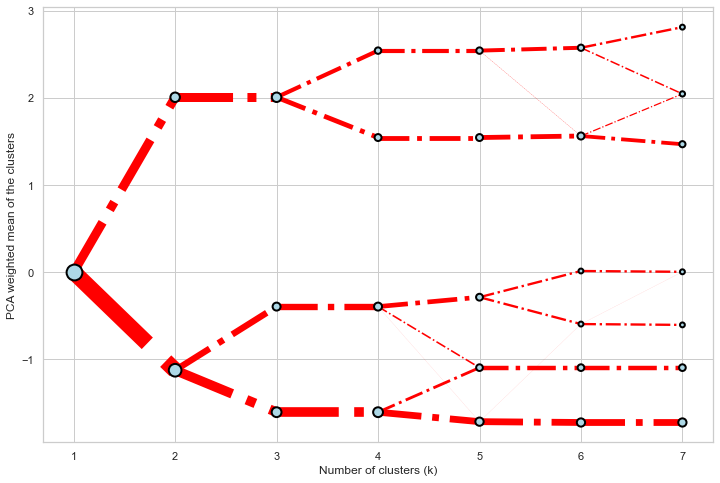
## Mean options
On the `y` axis, a clustergram can use mean values as in the original paper by Matthias Schonlau or PCA weighted mean values as in the implementation by Tal Galili.
```python
cgram = Clustergram(range(1, 8))
cgram.fit(data)
cgram.plot(figsize=(12, 8), pca_weighted=True)
```
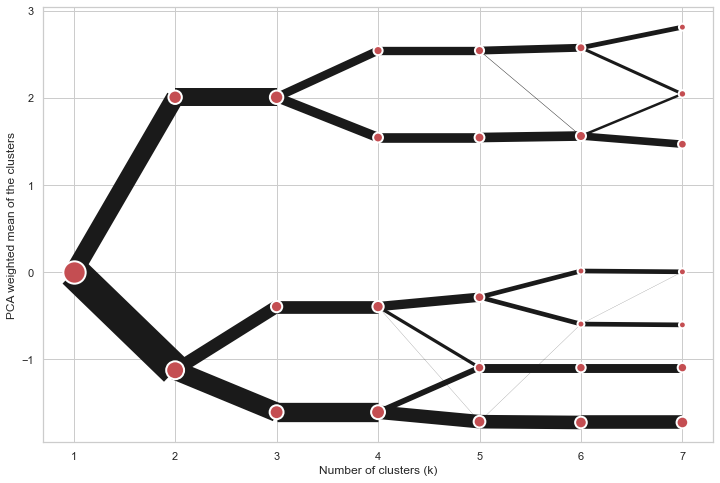
```python
cgram = Clustergram(range(1, 8))
cgram.fit(data)
cgram.plot(figsize=(12, 8), pca_weighted=False)
```
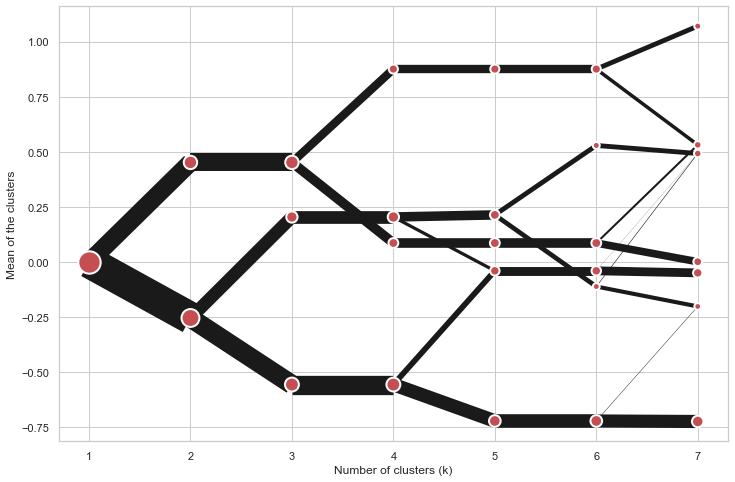
## Scikit-learn, SciPy and RAPIDS cuML backends
Clustergram offers three backends for the computation - `scikit-learn` and `scipy` which use CPU and RAPIDS.AI `cuML`, which uses GPU. Note that all are optional dependencies but you will need at least one of them to generate clustergram.
Using `scikit-learn` (default):
```python
cgram = Clustergram(range(1, 8), backend='sklearn')
cgram.fit(data)
cgram.plot()
```
Using `cuML`:
```python
cgram = Clustergram(range(1, 8), backend='cuML')
cgram.fit(data)
cgram.plot()
```
`data` can be all data types supported by the selected backend (including `cudf.DataFrame` with `cuML` backend).
## Supported methods
Clustergram currently supports K-Means, Mini Batch K-Means, Gaussian Mixture Model and SciPy's hierarchical clustering methods. Note tha GMM and Mini Batch K-Means are supported only for `scikit-learn` backend and hierarchical methods are supported only for `scipy` backend.
Using K-Means (default):
```python
cgram = Clustergram(range(1, 8), method='kmeans')
cgram.fit(data)
cgram.plot()
```
Using Mini Batch K-Means, which can provide significant speedup over K-Means:
```python
cgram = Clustergram(range(1, 8), method='minibatchkmeans', batch_size=100)
cgram.fit(data)
cgram.plot()
```
Using Gaussian Mixture Model:
```python
cgram = Clustergram(range(1, 8), method='gmm')
cgram.fit(data)
cgram.plot()
```
Using Ward's hierarchical clustering:
```python
cgram = Clustergram(range(1, 8), method='hierarchical', linkage='ward')
cgram.fit(data)
cgram.plot()
```
## Manual input
Alternatively, you can create clustergram using `from_data` or `from_centers` methods based on alternative clustering algorithms.
Using `Clustergram.from_data` which creates cluster centers as mean or median values:
```python
data = numpy.array([[-1, -1, 0, 10], [1, 1, 10, 2], [0, 0, 20, 4]])
labels = pandas.DataFrame({1: [0, 0, 0], 2: [0, 0, 1], 3: [0, 2, 1]})
cgram = Clustergram.from_data(data, labels)
cgram.plot()
```
Using `Clustergram.from_centers` based on explicit cluster centers.:
```python
labels = pandas.DataFrame({1: [0, 0, 0], 2: [0, 0, 1], 3: [0, 2, 1]})
centers = {
1: np.array([[0, 0]]),
2: np.array([[-1, -1], [1, 1]]),
3: np.array([[-1, -1], [1, 1], [0, 0]]),
}
cgram = Clustergram.from_centers(centers, labels)
cgram.plot(pca_weighted=False)
```
To support PCA weighted plots you also need to pass data:
```python
cgram = Clustergram.from_centers(centers, labels, data=data)
cgram.plot()
```
## Partial plot
`Clustergram.plot()` can also plot only a part of the diagram, if you want to focus on a limited range of `k`.
```python
cgram = Clustergram(range(1, 20))
cgram.fit(data)
cgram.plot(figsize=(12, 8))
```
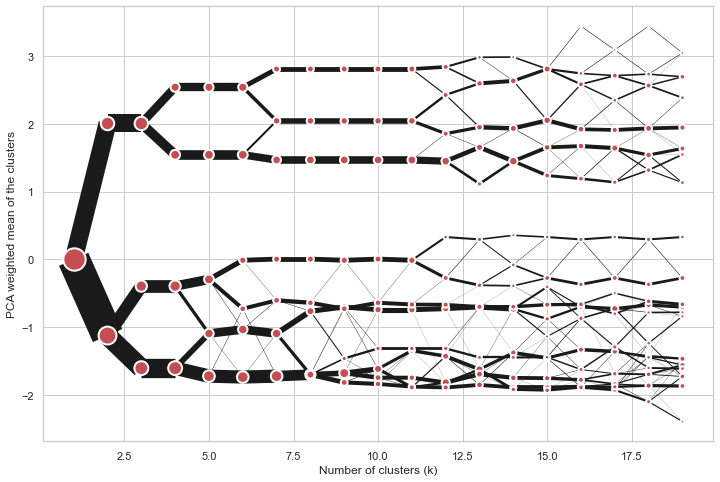
```python
cgram.plot(k_range=range(3, 10), figsize=(12, 8))
```
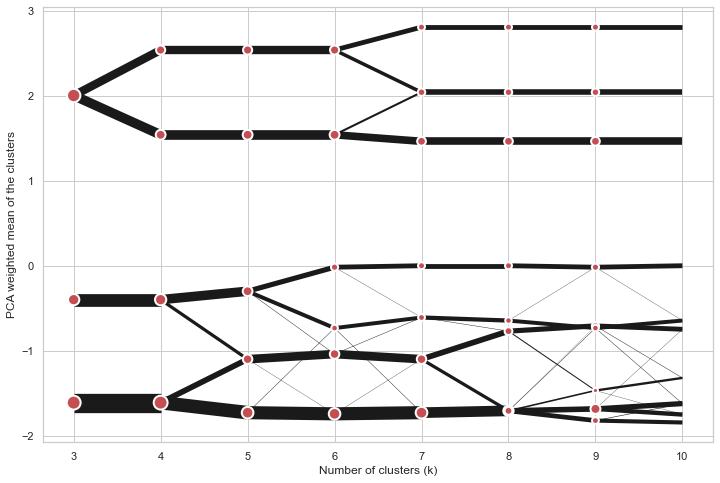
## Additional clustering performance evaluation
Clustergam includes handy wrappers around a selection of clustering performance metrics offered by
`scikit-learn`. Data which were originally computed on GPU are converted to numpy on the fly.
### Silhouette score
Compute the mean Silhouette Coefficient of all samples. See [`scikit-learn` documentation](https://scikit-learn.org/stable/modules/generated/sklearn.metrics.silhouette_score.html#sklearn.metrics.silhouette_score) for details.
```python
>>> cgram.silhouette_score()
2 0.531540
3 0.447219
4 0.400154
5 0.377720
6 0.372128
7 0.331575
Name: silhouette_score, dtype: float64
```
Once computed, resulting Series is available as `cgram.silhouette`. Calling the original method will recompute the score.
### Calinski and Harabasz score
Compute the Calinski and Harabasz score, also known as the Variance Ratio Criterion. See [`scikit-learn` documentation](https://scikit-learn.org/stable/modules/generated/sklearn.metrics.calinski_harabasz_score.html#sklearn.metrics.calinski_harabasz_score) for details.
```python
>>> cgram.calinski_harabasz_score()
2 482.191469
3 441.677075
4 400.392131
5 411.175066
6 382.731416
7 352.447569
Name: calinski_harabasz_score, dtype: float64
```
Once computed, resulting Series is available as `cgram.calinski_harabasz`. Calling the original method will recompute the score.
### Davies-Bouldin score
Compute the Davies-Bouldin score. See [`scikit-learn` documentation](https://scikit-learn.org/stable/modules/generated/sklearn.metrics.davies_bouldin_score.html#sklearn.metrics.davies_bouldin_score) for details.
```python
>>> cgram.davies_bouldin_score()
2 0.714064
3 0.943553
4 0.943320
5 0.973248
6 0.950910
7 1.074937
Name: davies_bouldin_score, dtype: float64
```
Once computed, resulting Series is available as `cgram.davies_bouldin`. Calling the original method will recompute the score.
## Acessing labels
`Clustergram` stores resulting labels for each of the tested options, which can be accessed as:
```python
>>> cgram.labels
1 2 3 4 5 6 7
0 0 0 2 2 3 2 1
1 0 0 2 2 3 2 1
2 0 0 2 2 3 2 1
3 0 0 2 2 3 2 1
4 0 0 2 2 0 0 3
.. .. .. .. .. .. .. ..
337 0 1 1 3 2 5 0
338 0 1 1 3 2 5 0
339 0 1 1 1 1 1 4
340 0 1 1 3 2 5 5
341 0 1 1 1 1 1 5
```
## Saving clustergram
You can save both plot and `clustergram.Clustergram` to a disk.
### Saving plot
`Clustergram.plot()` returns matplotlib axis object and as such can be saved as any other plot:
```python
import matplotlib.pyplot as plt
cgram.plot()
plt.savefig('clustergram.svg')
```
### Saving object
If you want to save your computed `clustergram.Clustergram` object to a disk, you can use `pickle` library:
```python
import pickle
with open('clustergram.pickle','wb') as f:
pickle.dump(cgram, f)
```
Then loading is equally simple:
```python
with open('clustergram.pickle','rb') as f:
loaded = pickle.load(f)
```
## References
Schonlau M. The clustergram: a graph for visualizing hierarchical and non-hierarchical cluster analyses. The Stata Journal, 2002; 2 (4):391-402.
Schonlau M. Visualizing Hierarchical and Non-Hierarchical Cluster Analyses with Clustergrams. Computational Statistics: 2004; 19(1):95-111.
[https://www.r-statistics.com/2010/06/clustergram-visualization-and-diagnostics-for-cluster-analysis-r-code/](https://www.r-statistics.com/2010/06/clustergram-visualization-and-diagnostics-for-cluster-analysis-r-code/)




